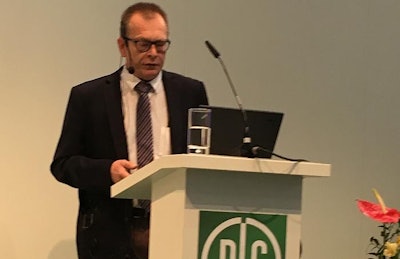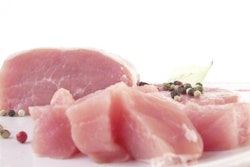
Livestock producers across Europe and Germany are coming under increasing pressure to reduce emissions and, while poultry may produce fewer emissions than other livestock species, poultry producers will nevertheless have to modify their production methods to comply with the changes on the horizon.
Dr. Volker Siemers, DLG TestService GmbH, presenting on emissions reduction techniques at EuroTier 2018, noted that pressure on producers was due to a number of factors.
In part, he noted, legislation was being revised to reflect the significant increase in the density of livestock production that has taken place over the last 10-15 years, and these revisions were coming were coming both at a German and European level. Additionally, he noted growing restrictions on production permits.
A new European Union (EU) directive implementing legislation in Germany, will see the country commit to cut total emissions by a fifth by 2030. Poultry producers, like other agricultural sectors, will have to work with ammonia levels that are 20 percent lower than what is currently permitted.
This may affect different producers in different ways, but all will have to ensure that they are officially recognized as compliant. Under the new livestock emissions act, where a new build is chicken farm with, for example, 40-80,000 birds, will have to install air exhaust systems. While these will not stop ammonia emissions, they will at least reduce them.
Existing buildings may have to be retrofitted. However, if reduction systems are already in place it may be possible to bring ammonia emissions into line with the forthcoming reduction through a adopting a combination of measures, and any measures taken within the house should contribute to reducing to overall production costs.
Rights and wrongs of modern production
Turing to the morals of modern poultry production, Professor Peter Kunzmann, of the University of Veterinary Medicine Hannover, noted that there is a huge gap between the commonly-held, perhaps romantic view, of animal production and what today’s livestock production actually is.
This gap is particularly evident where poultry production is concerned.
He continued that each individual bird, when compared to other animals like horses, is of low value, and because of this, producers need to keep birds in high numbers to make a living.
Additionally, a lot of technology needs to be employed to control birds’ environment and there is less human interaction. He also noted that genetic change has resulted in high performance and, at the same time, birds that very similar to one another.
The public then sees these large numbers of standardized, higher-performing birds as “factory farming,” with some arguing that the individual animal is lost or degraded.
But what is large-scale production, exactly, for some it may be when birds are kept in the low thousands, and he referenced the Sorites paradox by way of illustration.
This raises the question of whether those that protest against modern farming really understand what they are protesting against. If they do not, then why are there so many people who are concerned and, if they do, what exactly is it that they are protesting against?
When questioned, protestors tend to cite that birds do not have freedom of movement, or that they are fed antibiotics, or that they are not properly monitored.
Where legislation is concerned, it is also the individual animal that is referred to, not the flock or the herd.
However, when veterinary care is concerned, the veterinarian cares for the whole flock, not the individual bird, and there are cases where individual birds, sometimes in large numbers, such as in the case of disease outbreaks, are sacrificed for the good of the wider flock.
When humans view themselves they often fear the loss of individuality that can result from modern society, where the individual becomes lost in the crowd and is treated like an animal, and it is perhaps this fear that is that protestors have for animals.
But where ensuring animal health is concerned, the veterinarian has always addressed the flock, not the individual bird, and there are cases where individuals, even in large numbers, for example, in disease outbreaks, are sacrificed for the good of the wider flock.
There are examples of legislation that calls for the dignity of animals to be respected, including in cases where the numbers of animals kept are numerous.

















